Christ is risen! Truly He is risen!
icons by permission of Saint Isaac’s Skete at skete.com
Are you interested in the Place where you’re going? * I’m writing these articles to give us a taste of what it’s like There.
- Actually, one of the two possible places. Someday when I’m in a dark mood I’ll write about that other place, which I think is actually less than a “place”.
Before we get to today’s topic: Last week, as we looked at what Christ said about Heaven, I missed at least one thing. The Sadducees asked Him a trick question – about the woman who had had seven husbands: “Whose wife will she be at the resurrection?” Jesus answered authoritatively, as One who knew the answer first hand: “You are in error. You know neither the Scriptures nor the power of God. At the resurrection people neither marry nor are given in marriage; they will be like the angels in heaven.” Matthew 22:29-30
Western Christians say that Christ’s words mean that marriage ends at death: “…till death do us part.” Eastern Orthodox believe exactly what Jesus said: People do not “marry”- get married – in Heaven. We believe a marriage which endures on earth continues into eternity, where it will take new form and come to perfection. As Saint Paul wrote, marriage signifies the union between Christ and His Church: namely, mutual love which never ends. Ephesians 5:21-33
Last week we noted that, while Christ said that Heaven is a “Place” and told us what happens there, He never described the Place itself – presumably because it is so far above and beyond our concepts and images, that it cannot be described in earthly terms.
Yet the Book of Revelation does exactly that. It gives us a “pictorial” description of Heaven, the Heavenly City – and the Church (eventually) accepted The Revelation as canonical Scripture. How to explain this seeming contradiction? Perhaps because John made it fairly clear that his Revelation came only from a vision, and therefore the descriptions were only symbols, “pointers” into that Great Indescribable Reality. But I don’t know.
The Book of the Revelation of Jesus Christ to Saint John the Apostle, Evangelist and Theologian, sometimes called The Apocalypse
“Apocalypse” / αποκάλυψη means “the End of the World, usually by catastrophe”.
Before we get to the Heavenly City, I want to give you a brief introduction to this confusing and potentially misleading Book. Should you decide to read the rest of it, you should be forewarned.
If The Revelation is taken to refer to current events, some of its passages can be made to mean almost anything a person wants them to mean. (That’s how the Seventh Day Adventists came to believe that Christ returned in 1914.) I almost fell into this once. I had been reading the passage about the Great Battle of 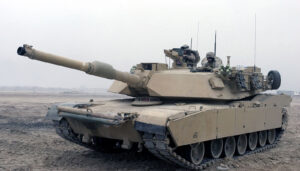 Armageddon which will precede the End of the World Revelation 16 and about the beasts with deadly stings in their tales. Revelation 9:10
Armageddon which will precede the End of the World Revelation 16 and about the beasts with deadly stings in their tales. Revelation 9:10
Camp Fallujah, Iraq, 2007 (public domain)
This was at the time of the First Iraq War, so I turned on the television to see the news. There were armed tanks battling it out not far from where some say Armageddon will take place, with long guns which look like stingers, shooting out deadly firepower. And I thought “Oh no! This is it!” That was forty years ago.
An early bishop * had many people who were reading Revelation and getting all “a-twitter” about it, as my mother used to say. He told them (I greatly paraphrase here): “Look. No one will understand the Book of Revelation till after the End comes, so Cool it! Don’t read it.”
- I can’t remember who or where or when. Does anyone here present know?
Good advice! unless you have a competent guide to help you. I’d suggest beginning with the footnotes in The Orthodox Study Bible: New Testament. If you want to dig deeper, here are some books (which I have not read, but I trust the authors and the source) available from the Ancient Faith Bookstore:
1 Revelation, a Liturgical Prophecy by Father Patrick Reardon
2 The Apocalypse of Saint John: A Revelation of Love and Power by Father Lawrence Farley
3 Ultimate Things; An Orthodox Christian Perspective on the End Times, by Dennis Engleman. This is not specifically about The Book of Revelation, but it puts it in perspective.
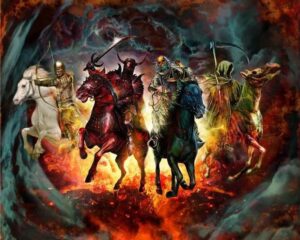
Because of all the easily-misunderstood and frightening passages, in the East it took about seven centuries for The Revelation to accepted as canonical Scripture. To this day it is never read publicly in the Orthodox Church – probably because our Lectionary was established before that.

There has been some (not unreasonable) controversy as to whether the Apostle actually wrote this book. (If anyone is interested, ask and we can go into this.)
However, earliest tradition was consistent that Saint John was the author. When I was on Patmos, I visited the cave where he wrote it. I’ll take early tradition over modern speculations.
Heaven
Throughout The Revelation we find image after image from the Old Testament. Did John receive these in an actual vision? Or was he only writing in symbols, known to his readers but unknown to the Romans, in order to shield Christians from the prying eyes of imperial persecutors? Or are there other explanations?
I don’t think we need to answer those questions now. Here let’s look only at the meaning of the symbols. I think it’s simplest to take them in order.
Here is what Heaven is like. Here is what we can expect. Here is how it will be at The End – that is to say, at The Beginning.
Worship
Chapter 4
John says he was lifted up to Heaven, where he witnessed a sort of amalgamation of Old Testament descriptions and prophecies – God upon His throne in glory, as in Daniel, being worshiped by elders and living creatures, rather like those in Ezekiel, who sing “Holy, holy, holy, Lord God almighty…”, as in Isaiah’s vision, as in our Divine Liturgy.
What happens in Heaven? Worship, praise of our glorious God. Recall those moments (I hope you have had some) when you were caught up in wonder, in worship, in the praise of God. It will be like that forever.
The Heavenly City, New Jerusalem
Chapter 21: 1-8
1 Heaven and earth will be made new again. “I saw a new heaven and a new earth, for the first heaven and the first earth had passed away.” Note: not a different heaven and earth, but God’s original creation re-newed. There will be “no more sea”. An odd thing to mention? But Jews hated the sea. They were no sea-farers. Out of the Mediterranean came the Romans and imperial oppression. The Sea to them was a symbol of chaos and disorder.
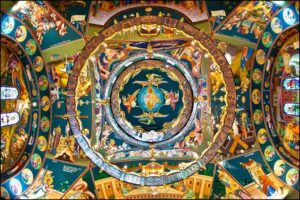
“Enthroned in the Heavenly Realm” (Russian, origin unknown) Granted that it is somewhat “busy”, it makes the point that we won’t be alone in Heaven!
2 The Holy City. Heaven is a City, a community. If your ideal is to care about nobody but yourself (“gimme my freedom!”), you’ll have to go somewhere else to find that. Heaven will be a Place where people from all the ages are united in love, in harmony. (By the way, an Orthodox church, filled with icons, is “Heaven on Earth”.)
One of my Anglican professors said that the Bible is the story of mankind’s journey from the Garden of Eden to the Heavenly City (with a big nasty detour along the way). We are moving from natural innocent happiness to intentional loving community.
3 The City will be the New Jerusalem. People are still fighting for control of Jerusalem and that land at the east end of the Mediterranean. Christians: forget it. Of course, Palestinians of whatever Faith should be treated justly, which they are not today. But Christians are citizens of the New Jerusalem, the true Jerusalem, which is above and beyond any earthly territory. “For here we have no continuing city, but we seek the one which is to come.” Hebrews 13:14
4 We will be united with God. The City will be “adorned as a bride for her bridegroom”. Christ and His people will be together forever. “Behold, the dwelling place of God is with men, and they shall be His people. God Himself will be with them and be their God.” Do you ever feel distant from God? that He is distant from you? Those days will be over.

5 “All my trials, Lord, soon be over.” This is a passage that always make me cry. Just as well we don’t read it in church – I’d never get through it. “And God will wipe away every tear from their eyes; there shall be no more death, nor suffering, nor crying… no more pain, for the former things have passed away.”
“Maranatha. Even so, come Lord Jesus!” Revelation 22:21 Please, Lord, soon.
6 The End. “And He said to me, “It is finished! I am the Alpha and the Omega, the Beginning and the End… He who overcomes shall inherit these things, and I will be his God and He shall be my Son.”
7 However, there are no “free passes”. Now comes a warning about who shall not enter the City: “cowardly, unbelieving, abominable, murderers, sexually immoral, sorcerers, idolaters, and all liars” shall go to “the lake which burns with fire and brimstone, which is the second death” – that is, the final death which can come after physical death.
Chapter 21: 9 – 22:5
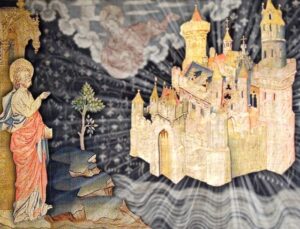
Now begins what appears to be a second account of the story of the Heavenly City. John again sees the New Jerusalem descending. I wonder: Is this an intentional parallel with the two Creation stories in Genesis?
1 Heaven descends to earth. Heaven has already existed “on high”. (“Thy will be done on earth as it is in Heaven.”) Heaven is also God’s creation, but in relation to earth has it always existed? always been there waiting to descend? In this imagery, Heaven by descending encompasses our “lower world”, so to speak, in its Glory.
2 The Description of the City. John uses terms taken from the Old Testament and perhaps some other apocryphal writings. Do not try to paint a picture of this. It can’t be done. The City contains the “Glory of God”, her light like clear jasper right 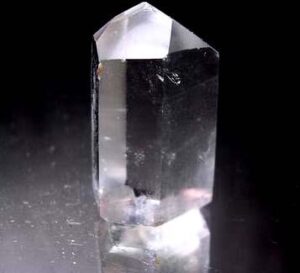 with twelve angels at its twelve gates “upon which are the names of the twelve tribes of Israel”. The old Jewish temple had twelve gates – so the old Israel is taken into the New Jerusalem.The city walls had twelve foundations, “on which were the names of the twelve Apostles”. “Built on the foundation of the apostles and prophets, with Christ Jesus Himself as the chief cornerstone.” Ephesians 2:12
with twelve angels at its twelve gates “upon which are the names of the twelve tribes of Israel”. The old Jewish temple had twelve gates – so the old Israel is taken into the New Jerusalem.The city walls had twelve foundations, “on which were the names of the twelve Apostles”. “Built on the foundation of the apostles and prophets, with Christ Jesus Himself as the chief cornerstone.” Ephesians 2:12
3 The City is huge! Translated into British/American usage, it is 1400 miles square and about 240 feet high. Will there be room for everybody? Yes.
4 The City is beautiful beyond imagining. The walls are made of jasper, the foundations of precious gems, the gates themselves are pearls, and the streets “pure gold, like transparent glass”.
5 God will be completely accessible to us and we to Him. The City “has no temple in it, for the Lord God Almighty and the Lamb are its temple”. No need for propitiatory sacrifices to win God’s favor. Our Divine Liturgies will be swallowed up into the heavenly worship. There will be no need of sun or moon for God’s Glory will illuminate it. Jesus “the Lamb is its Light.” (“He was the true Light which gives light to every man coming into the world.” John 1:9) John was likely thinking also of Christ’s Transfiguration and its blinding Light which he could not bear,. And his vision at the beginning of this Book, of Christ in blinding light which now he could see – chapter 1:10-18.
6 All that is good on earth will be saved. “The nations of those who are saved shall walk in its light, and the kings of the earth bring their glory and honor into it.” On earth we have grown in knowledge and wisdom and love of God and all good things. Will that be lost? No. We shall carry it with us into the New Jerusalem.
7 There will be security. The City’s gates shall never be shut, for there shall be no night there – no danger, no need for fear or worry. No persecution.
8 All shall be healed there. “A pure river of life, clear as crystal proceeds from the throne of God… the tree of life bearing fruits… and the leaves of the trees are for the healing of the nations.” We will return to the Garden of Eden. That which we all long for – a world where all our strife and conflict and suspicion will end, and we will live in peace. We will find it in that City.
9 We shall we Jesus Christ. His servants “shall serve Him.. shall see His Face.” This Man whom we have loved and served and followed and longed for all these years – “We shall look upon the Face of Jesus Christ.”
10 “His Name shall be written on their foreheads.” There are probably two symbols here: In the Old Testament, the name of God was considered too holy to speak or even write, so the high priest alone wore a small golden plate on his forehead on which was written the unutterable Name of God. Now all will know and praise our all-holy God.
Also, in the early Church, Christians used the Sign of the Cross to identify themselves with each other, but did so furtively, making it only on their foreheads, lest the Romans should see and know them. Now Christians will no longer be afraid.
11 It will never end. For in His Light, His servants “shall reign for ever and ever.”
These are the symbols by which the Apostle John described what is coming, the unimaginable beauty and joy of the Holy City, the New Jerusalem. That is our future, if we choose it.
If we choose it. Just before the end of his vision, John warns again that the gates of the New Jerusalem will be closed to some: “Outside [the City are] dogs * and sorcerers and sexually immoral and murderers and idolaters and whoever loves and practices lies.” (John was taught by His Lord to hate lying. Read his Gospel 8:41-45.)
- He didn’t mean your pet poodle! In those days dogs were not yet tamed. They were beasts who roamed about, snarling and growling and grasping – and barking all the time, as the two dogs behind our house are doing even now!

On that note, John’s Revelation of the City of God, the New Jerusalem, faded away and was gone.
Next Week: Another Image –The Holy Mountain from Saint Ephraim of Syria and (if we get that far) C.S. Lewis.
These Posts were intended to be shorter than usual. Why are they longer than usual? Next week I’ll try again.

Wondering about the idea of a “second death.” This directly contradicts the good news of the Resurrection and Christ’s direct teachings. I can see why there was procrastination to add Revelations and think it wise that it’s not part of the lexicon. Dream symbolism is good, worthy of great discussions, but I’m disinclined to give it definitive authority.
Oh, Laurel, I wish I agreed with you!
The Revelation has authority because the Church (Orthodox people as a whole) accepted it as authoritative. However, there has never been a general consensus about how the Book should be interpreted. Here’s a good article about it: https://www.michaeljkruger.com/the-book-of-revelation-how-difficult-was-its-journey-into-the-canon/
Yes, Christ’s Resurrection opened Life, Glory, Heaven to all. Before then, Greeks and Jews believed that at death we disappeared into the dark Underworld. Other peoples believed various things, based mostly on dreams and visions and what not. Christ taught clearly that Heaven is for everyone, and He rose again Bodily to show what we can have and lead us into it.
He also taught very clearly about the other possibility, Hell: Read Mark 9:44-48 or Matthew 25:41-44. God gave us free will to choose or not. In fact, I think He was the first to warn us about this. As C.S. Lewis wrote, In the end either we will say to God “Thy will be done”, or He will say to us “Alright. Your will be done.” If you don’t want Me and love and joy, that’s up to you.” We can hope that in the End, all will be saved, but that’s up to us.